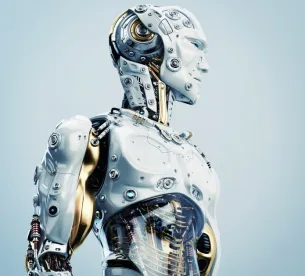At the most recent SXSW, Hanson Robotics, based in Plano, TX, debuted its latest personal robot – Sophia. With lifelike skin that is made from patented silicon, Sophia can emulate more than 62 facial expressions. Cameras inside her “eyes,” sophisticated computer algorithms, and a combination of voice recognition technology and other tools enable Sophia to “see” and “think.” Sophia is just the latest example of major advances in the development of machines striving to attain human “characteristics,” “intelligence,” and “awareness”.
Creepy? Maybe. Predestined? Definitely.
Life Imitating Fiction
Arguably, the notion of Artificial Intelligence (AI) or Cognitive Computing has been around since Frankenstein was published in 1818. For example, consider the Star Trek series, especially The Next Generation, where AI is prevalent. The android DATA was imparted with human-level intelligence and expertise by his creator, Dr. Soong. Albeit fictional, DATA is an example of a machine achieving human-level awareness. Conversely, Seven of Nine (or more specifically the Borg/Borg Collective) is essentially a human or humanoid that has been assimilated and made more machine-like, striving for efficiency and perfection of a machine. The Borg individual is given artificial limbs, eyes, and other body parts, as well as implants (for example, brain implants), so that each Borg individual can communicate with the Collective and the Borg Queen.
Now contrast DATA or Sophia with the Borg or Borg Collective. If you look at the two ends of the DATA vs. Borg spectrum, where DATA strives to be more human-like and a Borg (assimilated human) strives to be more machine-like, at some point, there is going to be a convergence — at which point it may be difficult for us to tell which is which OR which is better.
If you think that the Borg scenario is far-fetched, just think about what medical science has developed over the last few decades:
-
We have a working robotic foot that can help an amputee replicate natural foot movement, developed by an MIT professor;
-
We have sensors and implants in humans that can monitor and regulate functions and conditions, that can dispense drugs;
-
We are getting more sophisticated in the development of an artificial eye to help the blind to see; and
-
It was recently reported that the US military is initiating a program to develop advanced implants, the size of a nickel, that can be implanted into the brain to allow the human brain to communicate directly with computers, as a way to enhance audio and visual capabilities.
Rise of the Machines and The AI of Things
Many experts have identified a timeline of 50 to 150 years before machines can attain human-level intelligence or awareness. As for turning a human into a Borg? Perhaps we are not so far off. For some of you reading this blog, you may find yourselves routinely interacting with a DATA or Seven of Nine within your lifetime.
When considering the emergence of AI, the question is whether these advances will help us or overcome us. In the short term, it’s more likely that these advances will help us. Look at today’s autonomous robotic vacuum cleaners, self-driving cars, artificial limbs, artificial cochlea, etc. These machines are all designed with a very narrow or specific purpose. Even with something as sophisticated as Hanson Robotics’ Sophia, the mission is to develop personal robots that can be helpful to humans, including those with disabilities. Also, the current technology is so disparate or disconnected from one another that there is little concern about this type of AI overcoming us any time soon. However, with the advances of a connected world (the Internet of Things, where machines are able to communicate with one another), perhaps we will see the rise of machines, the “Singularity” happening when the intelligence of the machine surpasses that of a human.
I am not sure when something like Skynet in The Terminator or the Matrix in the movie of the same title will surface. But I am certainly aware that more companies are filing for patent protection in this space. I do hope, however, that I won’t be around if and when that does happen, and hope that these movies are not a premonition of things to come.



 />i
/>i

